Accelerating action on SDG 14, the ‘lagging’ SDG
Sunday, 29 May 2022
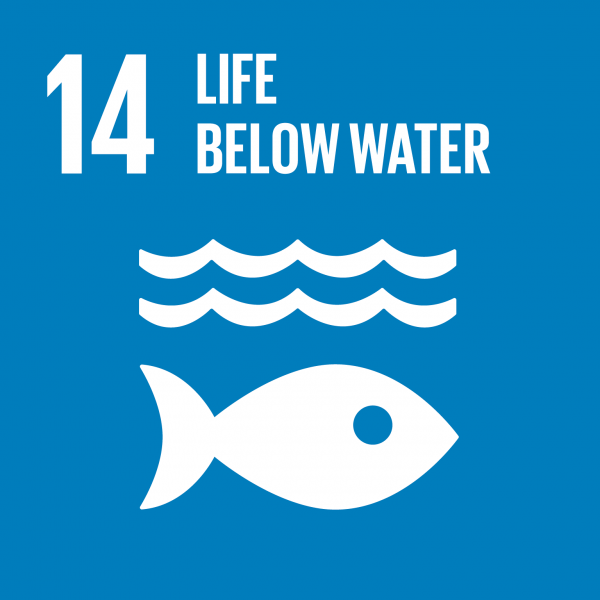
Partnerships in Environmental Management for a Seas of East Asia is an international coordinating mechanism whose mission is to foster healthy and resilient coasts, people and economies in thr East Asian Seas (EAS), PEMSEA is committed to move as one with the global ocean agenda and is applying integrated coastal management as a building block to promote blue economy pathway.
Ahead of the UN Ocean Conference co-hosted by the governments of Kenya and Portugal on 27th June-1st July 2022, PEMSEA releases this policy brief summarizing the progress of implementing SDG 14 in the EAS region. The policy brief is based on the speech delivered by Dr. Andrew Hudson, Head of Water and Ocean Governance Programme, UNDP, as one of the keynote speakers at the Main Conference of the EAS Congress 2021 held last 1 December 2021 . PEMSEA is grateful to Dr. Hudson for his guidance and longstanding support to the organization over the past 28 years.
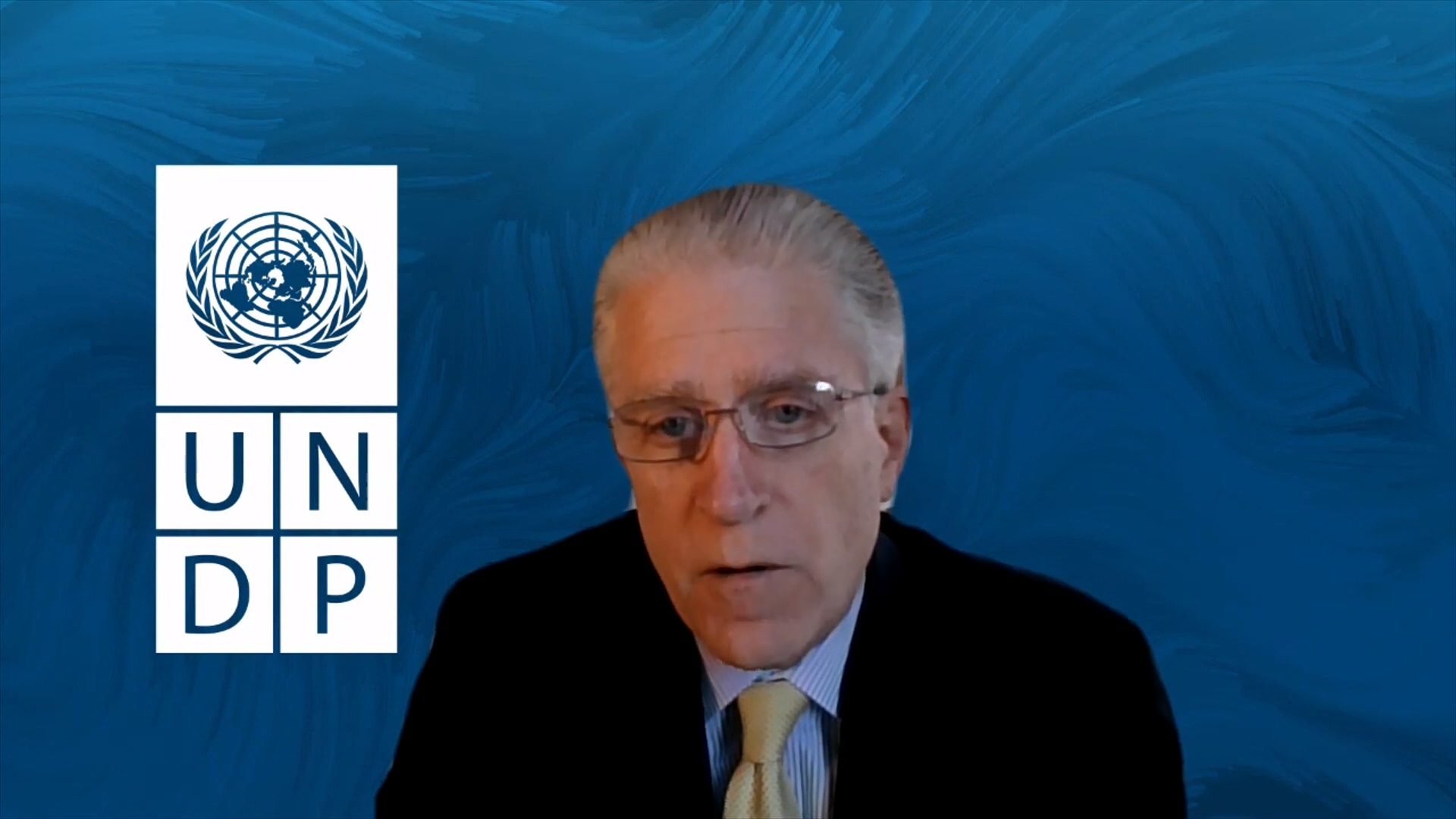
The Sustainable Development Goals (SDGs) were created as an interlinked set of mutually reinforcing targets, with meeting all of them required to reach the ultimate vision of a sustainable future for our planet and its people. A failure to meet one SDG target will ripple through the actions taken to achieve other outcomes, reducing potential sustainability achievements in multiple sectors. A 2020 report by the Asia-Pacific SDG Partnership, Fast-tracking the SDGs: Driving Asia-Pacific Transformations, highlights the need in the region to accelerate SDG progress across the board in the region, especially in light of the setbacks caused by the COVID-19 pandemic.
With less than a decade left before the SDG target date, one SDG, SDG 14 (Life Below Water), stands out as being uniquely off-track, and in urgent need of further attention. This article provides a quick overview of its status and implementation, and offers some suggestions on how we can ‘turn the tide’ to accelerate the progress of SDG 14 within the seas of East Asia.
Efforts to respond to and recover from the global pandemic could also create a unique opportunity for rethinking “business as usual” – Asia-Pacific SDG Partnership 2020
Ambitious targets
The scope of SDG 14 is enormous. The ocean, including both territorial and international waters, covers over 70% of the planet. Within it are diverse ecosystems, separated by geography, depth, currents, and local conditions. SDG 14 was also ambitious in its timeframe, including four targets that had completion dates of 2020 and one aimed for completion in 2025, in addition to the 2030 goals.
Human reliance on and interaction with the oceans has been a constant throughout history, with seas and oceans functioning as nutrition sources, facilitators of the trade of goods and services, and contributors to culture and the formation of values. Human activities threaten ocean health and sustainability in similarly varied ways. Local and global ocean issues are interlinked, with local threats potentially having global impact and vice versa. To tackle these challenges, SDG 14 is divided into 10 targets covering different aspects of ocean sustainability.
In the Asia and the Pacific SDG Progress Report 2021, UNESCAP shared the progress of every SDG since the year 2000. While there is room to improve on all indicators, only two, SDG 13 (Climate Action) and SDG 14 show a regression, and SDG 14 shows not only a much larger regression, but a corresponding lack of indicator data needed to monitor and guide potential progress. Of the 10 SDG 14 targets, 14.5 (Conservation of coastal areas) is classified as needing acceleration, 14.1 and 14.7 (Marine pollution and Marine resources for SIDS and LDCs respectively) are classified as having regressed. The other seven are considered data deficient, and thus difficult to assess. In this paper, we have grouped the targets thematically, although every target interacts with the others and the need for holistic solutions is a priority.
Some progress has been made on protecting coastal areas, but economic benefits from sustainable fisheries and the quality of oceans have declined. These goals are also among the most data-poor and so more must be done to increase data availability for a more robust progress assessment. – UNESCAP, Asia and the Pacific SDG Progress Report 2021
14.1 By 2025, prevent and significantly reduce marine pollution of all kinds, in particular from land-based activities, including marine debris and nutrient pollution
The broad scope of 14.1, covering “all kinds” of pollution, reflects the increasing knowledge about various pollutants. Much international attention has recently been focused on marine plastic pollution for example, but such attention is recent and marine pollution takes on many less-visible but still pernicious forms. The specific reference to “land-based activities” highlights that much of the pollution pressure put on the oceans is not from activities within the oceans themselves as might be expected, but from pollution occurring on land and exported into the oceans through various means, notably via polluted rivers.
Marine debris is one of the two specific pollution types mentioned. It is a highly visible form of pollution, and waste from the land has the potential for dramatic impact on the ocean. The most currently well-known debris form is plastics, which has the highly visible effect of direct harm to marine animals, alongside less visible impacts such as blocking oxygen exchange to benthic environments and producing microplastic pollution. A sizeable fraction of this plastic comes from land via rivers, with East Asia being the global hotspot for such pollution (Meijer et al. 2021). The growing population and economies in the region are likely to continue adding pressure to already-weak waste management systems.”
Nutrient pollution is a less visible but often deadly form of pollution. High levels of nutrients result in reduced oxygen levels in the ocean, which sometimes reach a point so low that areas are referred to as “dead zones”. Multiple such zones have been identified in East Asia (Breitburg et al. 2018). Such zones are also the result of land-based pollution, as rivers deliver man-made nutrients to coastal areas, primarily those derived from agricultural run-off including both fertilizer and poorly managed manure.
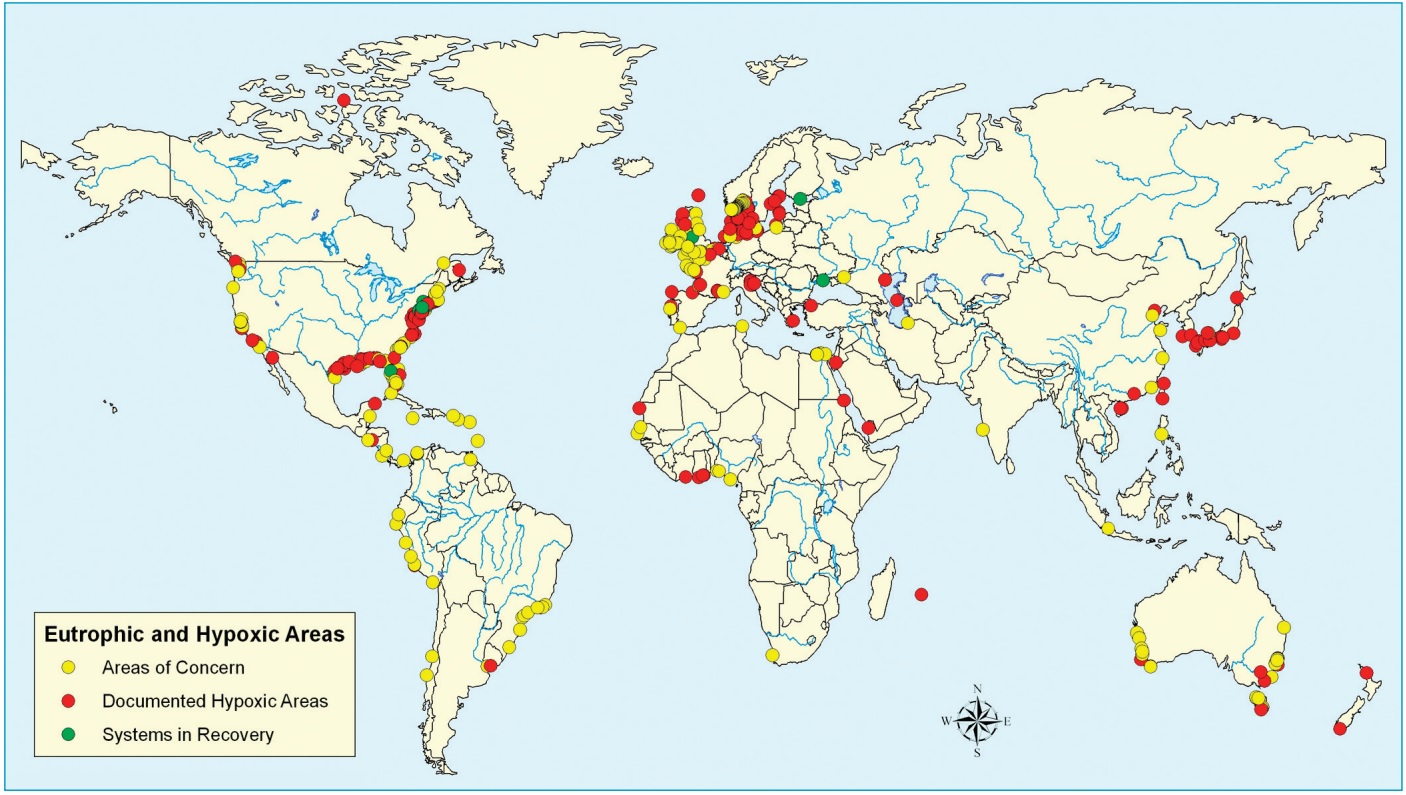
The number of identified hypoxic areas in 2008. Other spots have been identified since then, and many likely remain undocumented. (World Resources Institute 2008)
Some gaps remain in understanding the pathways of pollutants from the land to the ocean, as well as in effective techniques to “prevent and significantly reduce” such pollution. Nonetheless, enough is known to confidently state that this is one of the indicators showing regression. Such waste has worsened during the Covid-19 pandemic, as waste from items such as personal protection equipment (PPE) increased significantly. By August 2021, it was estimated that at least 25,000 tons of pandemic-related waste had leaked into the oceans, of which 72% came from Asia (Peng et al. 2021).
14.2 By 2020, sustainably manage and protect marine and coastal ecosystems to avoid significant adverse impacts, including by strengthening their resilience, and take action for their restoration in order to achieve healthy and productive oceans
14.5 By 2020, conserve at least 10 per cent of coastal and marine areas, consistent with national and international law and based on the best available scientific information
14.c Enhance the conservation and sustainable use of oceans and their resources by implementing international law as reflected in the United Nations Convention on the Law of the Sea, which provides the legal framework for the conservation and sustainable use of oceans and their resources, as recalled in paragraph 158 of "The future we want"
The protection of marine and coastal ecosystems is crucial for sustaining vital ecosystem services such as the provision of food, the cycling of nutrients, promoting coastal resilience, and carbon sinks. Ecosystems such as mangroves, coral reefs, and seagrass meadows have seen their extent greatly reduced. From an estimated area of almost 190,000 km2 in 1980, mangroves were reduced to under 136,000 km2 by 2016 (Global Mangrove Alliance 2021). The coasts of Southeast Asia remain a global mangrove hotspot. Coral has decreased by around 14% worldwide, although reefs within the seas of East Asia have shown more resilience than elsewhere (GCRMN 2021). Seagrass meadows in the seas of East Asia have shrunk at a rate of 4.7% per year since 2000, although there is significant local variation (Sudo et al 2021).
Managing and protecting marine and coastal ecosystems is a broad remit, and is usually achieved through the establishment of some sort of management system. The most common management tool for doing so is the marine protected area (MPA). They vary in size, specific purpose, and quality, so it is hard to precisely assess them. Estimates therefore vary, but perhaps around 7% of the oceans fall within MPAs as of April 2021 (Kriegl et al. 2021). These targets were ambitiously aimed for 2020, in line with the Aichi targets. They have yet to be fully achieved, although work is ongoing in East Asia and elsewhere. These national protection targets also leave unaddressed the significant and complex issue of managing international waters (e.g., areas beyond national jurisdiction, ABNJ), a topic on which no comprehensive international consensus has been achieved (negotiations on an ABNJ agreement continue at the United Nations). 14.5 is considered in need of acceleration by UNESCAP, while 14.2 and 14.c remain data deficient.

Area of territorial waters considered protected (Our World in Data 2018)
14.3 Minimize and address the impacts of ocean acidification, including through enhanced scientific cooperation at all levels
As industrial carbon output has increased, the oceans have acted as a massive carbon sink. In the 21st century, perhaps a quarter of all carbon dioxide emissions were stored in the ocean (IPCC 2019). While this has delayed global temperature rises, it has increased the acidity of the oceans. Such acidity is directly harmful to marine life, for example by preventing shellfish from forming their shells. This has knock-on effects for seafood farmers and communities who rely on these animals for their livelihoods and food security, as well as to the wider ecosystem.
With ocean acidity already having substantially increased, it is expected to reach a global state of almost constant extremes compared to pre-industrial times (Burger et al 2020). It is directly linked with climate change, which is covered by another SDG (13) which unfortunately shows regression in the Asia-Pacific region.

Prediction of average ocean pH (lower = more acidic) under a business as usual (BAU) scenario (Turley 2006)
14.4 By 2020, effectively regulate harvesting and end overfishing, illegal, unreported and unregulated fishing and destructive fishing practices and implement science-based management plans, in order to restore fish stocks in the shortest time feasible, at least to levels that can produce maximum sustainable yield as determined by their biological characteristics
14.6 By 2020, prohibit certain forms of fisheries subsidies which contribute to overcapacity and overfishing, eliminate subsidies that contribute to illegal, unreported and unregulated fishing and refrain from introducing new such subsidies, recognizing that appropriate and effective special and differential treatment for developing and least developed countries should be an integral part of the World Trade Organization fisheries subsidies negotiation
14.b Provide access for small-scale artisanal fishers to marine resources and markets
Fisheries are an enormous boon for human society, providing an accessible protein source both for small-scale fisherfolk and for larger fishing operations. The ocean bounty can sometimes appear inexhaustible; however, many fisheries find themselves under strain. Fish consumption has doubled since 1990, and from 10% of fish stocks being overfished in 1974, 34.2% were in 2017 (FAO 2020).
Fisheries are particularly important for Asia, the countries of which run 68% of global fishing vessels (FAO 2020). Proper management can often lead to sustainable management of fishing, and even to the recovery of overfished populations. Aside from large-scale fishing, supporting smaller fisherman and providing them with better market access can improve their livelihood options and reduce the pressure on more devastating fishing techniques such as dynamite and cyanide fishing.

Status of global fish stocks (FAO 2020)
Fisheries management needs sufficient data and understanding to be successful. Even with management, fishery sustainability can be undercut by illegal, unreported, and unregulated (IUU) fishing. Monitoring this is difficult as well. Even among monitored fisheries, issues abound relating to unsustainable practices. Fisheries subsidies can worsen the impacts on already depleted fisheries, as well as contribute to IUU fishing. International discussions are ongoing through the World Trade Organization on reducing harmful subsidies (FAO 2020).
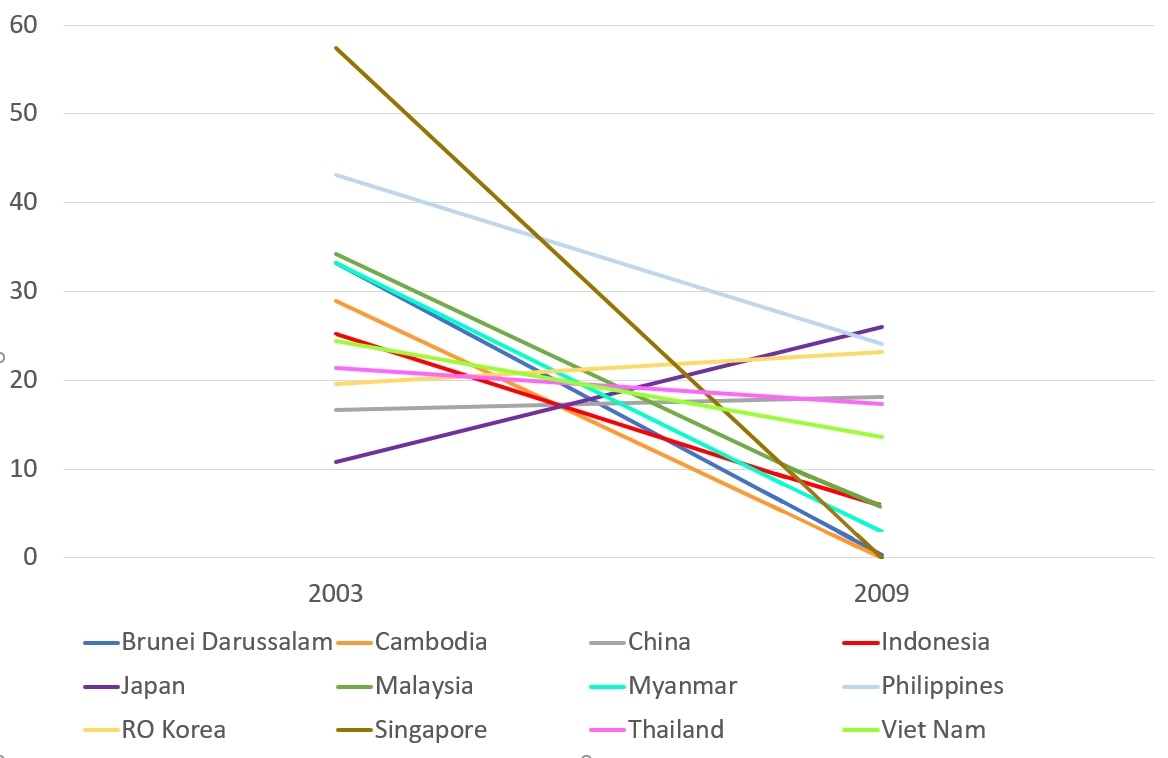
Fisheries subsidies in terms of percentage of landed value (Sea Around Us 2021)
14.7 By 2030, increase the economic benefits to small island developing states and least developed countries from the sustainable use of marine resources, including through sustainable management of fisheries, aquaculture and tourism
14.a Increase scientific knowledge, develop research capacity and transfer marine technology, taking into account the Intergovernmental Oceanographic Commission Criteria and Guidelines on the Transfer of Marine Technology, in order to improve ocean health and to enhance the contribution of marine biodiversity to the development of developing countries, in particular small island developing States and least developed countries
Asia has 85% of the world’s aquaculture workers, and is expected to make up 89% of the additional aquaculture growth leading up to 2030 (FAO 2020). This is an area where Asia leads globally. Similarly, much of coastal East Asia has a history of eco-tourism, and is primed to further develop this sector. Taken as a whole, the ocean-related economy makes up a significant percentage of the economies of East Asian countries. For the two LDCs in the region, Cambodia and Timor-Leste, the ocean is linked to 16% and 87% of their GDPs respectively (PEMSEA 2021).
Despite its importance, target 14.7 is seen as regressing in the Asia-Pacific. In part this is linked to a lack of progress in other targets; if marine resources are damaged, they become less productive and less valuable. It is hard to market a bleached reef to tourists such as divers. Conversely, more work needs to be done on promoting sustainable use of existing resources, which remain underutilized. Utilization of such resources requires knowledge, capacity, and initial capital that may not be so easily accessed by LDCs.
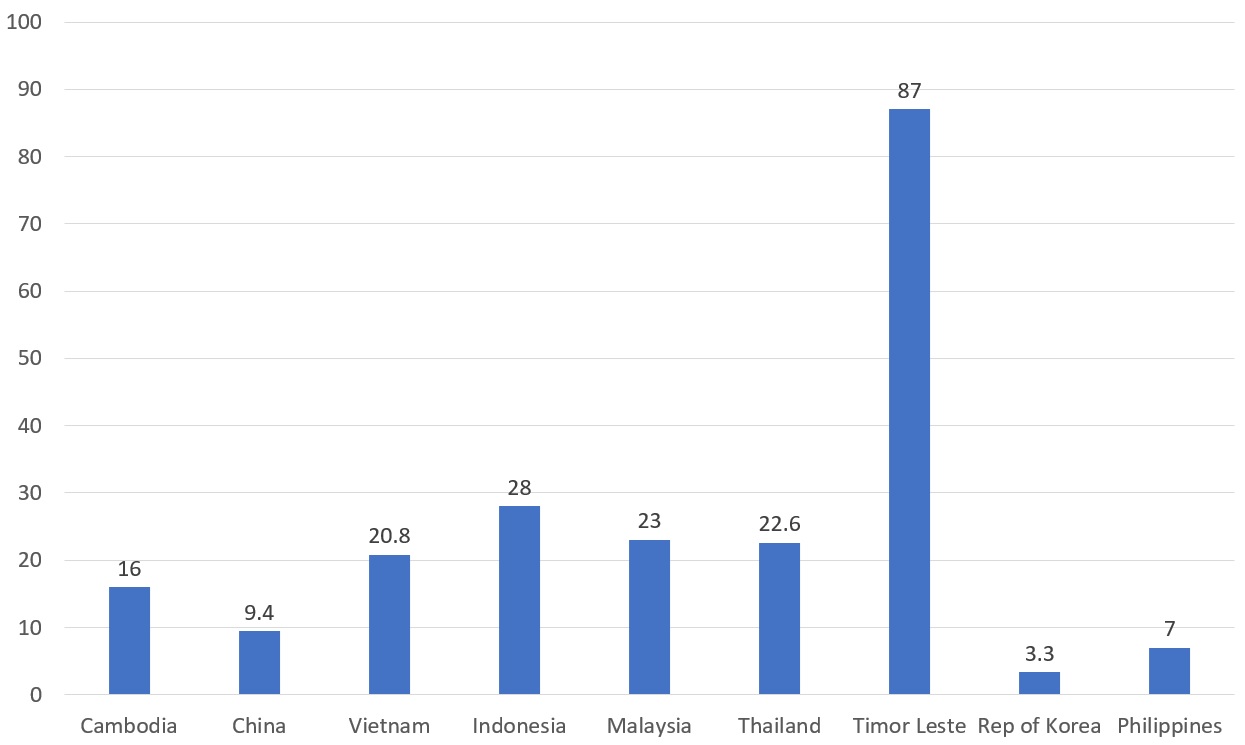
Ocean-related economy as a percentage of total GDP (PEMSEA 2021)
How to build progress
This somewhat gloomy overview obfuscates the progress that has been ongoing and emerging throughout the seas of East Asia. Historical and current connections to the ocean make it a valuable resource for communities throughout the region, and in many areas East Asia is a global leader in the development of a sustainable blue economy.
Every country in the region is taking steps to achieve the goals of SDG 14. Research spending on ocean issues is increasing, fisheries management is improving, and sectors like aquaculture and eco-tourism are being developed. Increasing action is being paid to marine plastic pollution and the waste management systems that underpin potential solutions. For example, a dedicated program covering both early intervention and cleanup has led to a significant reduction in marine litter found in the waters of RO Korea (YSLME 2022).
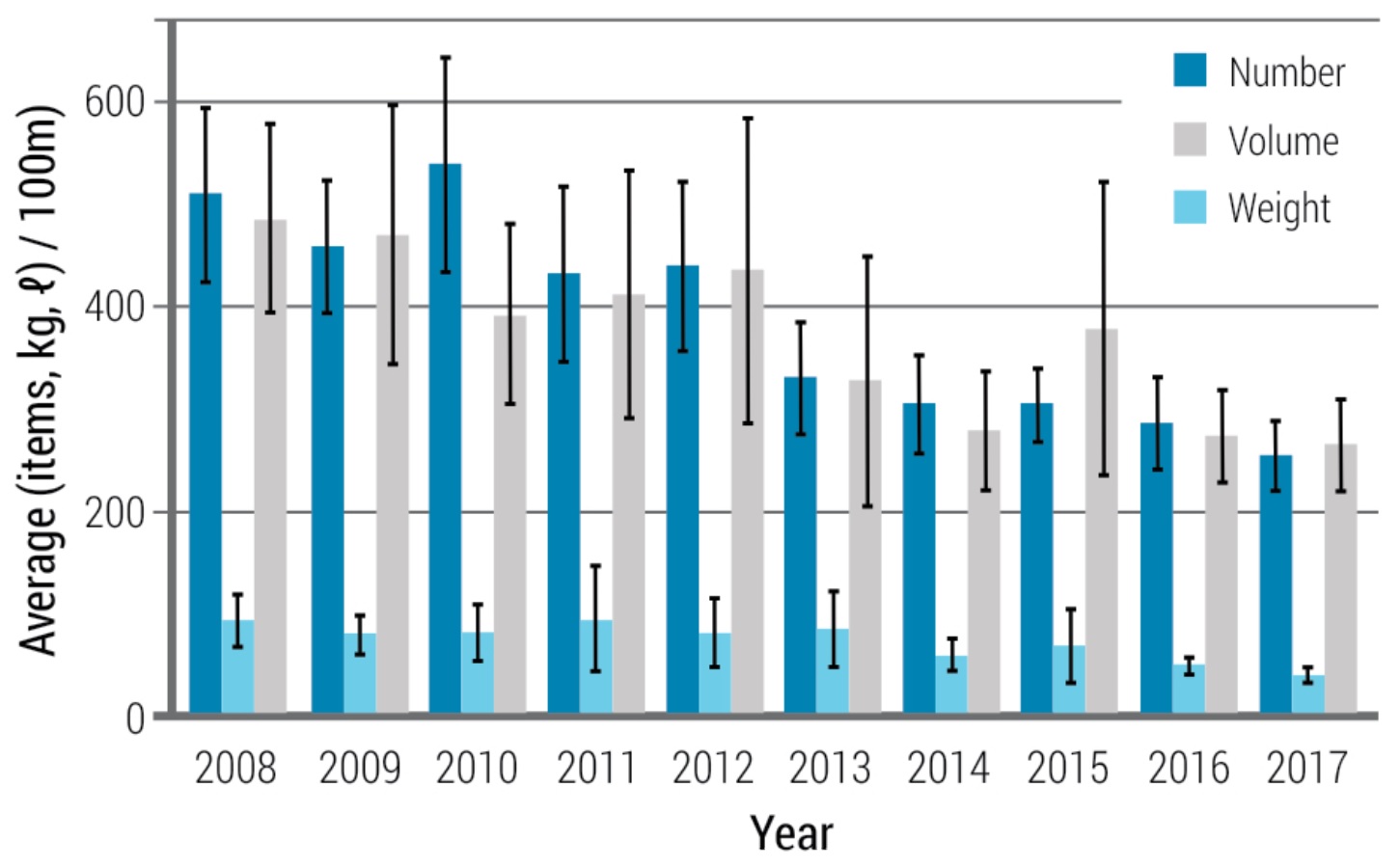
Macro-litter found in the waters around RO Korea (YSLME 2022)
Countries in the region have signed up to the Paris Agreement and other international treaties and protocols which support sustainable development. Individual actions such as these must be fitted into a holistic framework of solutions, reflecting the holistic nature of the issues as recognized by the structure of the SDGs. Countries in the region are doing so. Cooperation, both bilateral and multilateral, is increasing at both national and local levels.

Some of this cooperation is being handled through organizations like PEMSEA. Eleven (11) countries in the region have signed up to the Sustainable Development Strategy for the Seas of East Asia (SDS-SEA) (PEMSEA 2015). Jointly developed with sustainability goals such as the SDGs in mind, the SDS-SEA looks at actions that can be taken that would improve both local and regional outcomes. Its latest implementation plan (PEMSEA 2018) follows a similar holistic strategy, creating 3 priority management programs (Biodiversity conservation, Climate change and disaster risk reduction, and Pollution reduction and waste management) and 3 governance programs (Ocean governance and strategic partnerships, Knowledge management and capacity building, blue economy investments and sustainable financing).
These programs are mutually reinforcing, and work towards different aspects of SDG 14 (alongside other SDGs). For example, 14.1 is tackled primarily through the Pollution reduction and waste management program, with support from the Knowledge management and capacity building program. The areas of SDG 14 linked to MPA management and fisheries fall primarily under the Biodiversity conservation program and the Ocean Governance and strategic partnerships program. For all examples, aspects of other programs feed into each other, such as business investments under the Blue Economy investments and sustainable financing program affecting the Pollution reduction and waste management program, and Sustainable cities and Vulnerability risk assessments under the Climate change and disaster risk reduction program affecting fisheries and MPA management aspects of the Ocean governance program.
The countries have reinforced their commitment to actions under the SDS-SEA through joint ministerial declarations, the latest in 2021 (PEMSEA 2021b). The PEMSEA Network of Local Governments (PNLG), connecting more local policy makers throughout the region, has issued its own joint statement on the need to cooperate in tackling the regional issue of marine debris (PEMSEA 2019). Such regional agreements may be important pre-cursors to the proposed development of further international agreements on handling marine debris.
The holistic requirements of meeting the goals of SDG 14, as well as those of the other SDGs, is reflected in the Integrated Coastal Management (ICM) strategy which PEMSEA assists countries and local governments in developing and iterating. Such structures directly support the goals of SDG 14 which link to management, and 114 ICM sites have been established throughout the region, covering 40.4% of its 225,000 km coastline. ICM explicitly drives towards sustainability, both environmental and economic. This supports coastal ecosystems as well as the communities that benefit from them, such as small-scale and artisanal fisheries. Global impact is achieved through measures relating to reducing carbon and waste output in ICM sites.
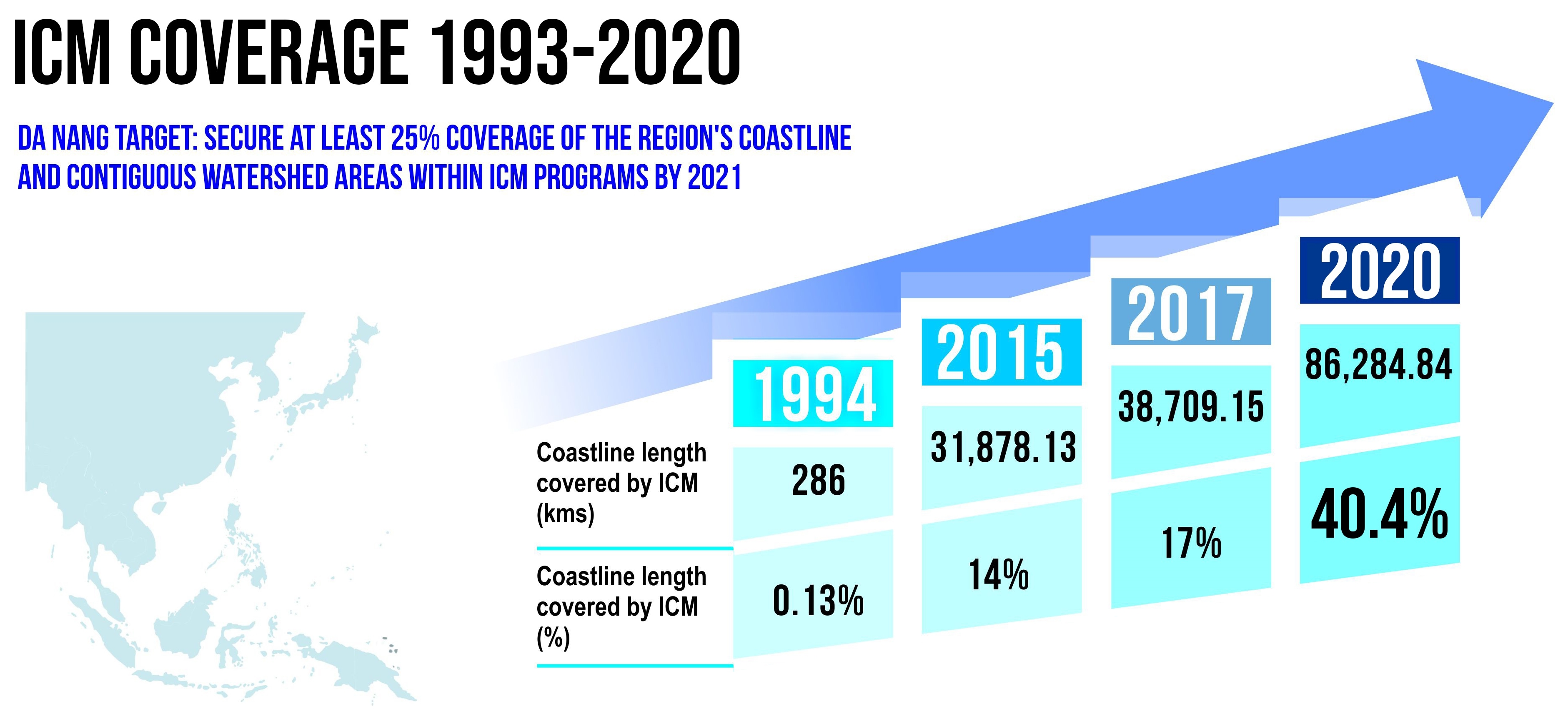
With much work needed on SDG 14, and with the existing SDS-SEA implementation plan expiring at the end of this year, it is important for the region to develop an updated framework for improving ocean management and sustainability. PEMSEA is preparing its roadmap to 2030 to match the timeframe of the SDGs and take into account actions and recommendations of the ongoing UN Decade of the Ocean. Other multilateral and regional bodies are also focusing on the oceans, amid the growing development of the Blue Economy concept. For example, the Asian Development Bank (ADB) has an Action Plan for Healthy Oceans and Sustainable Blue Economies (ADB 2021), and World Bank has established its PROBLUE program (World Bank 2021). Under its Water & Ocean Governance Programme, UNDP recently launched its Ocean Innovation Challenge (2019) as well as the Blue Economy in the SIDS (2020).
The international community is also taking further action, with the UNEA-5 meeting agreeing in March 2022 on a commitment for a legally binding agreement on plastic pollution within the next two years (UNEP 2022). An international treaty would be a significant step towards meeting the needs of SDG 14.1, and the regional expertise developed within the seas of East Asia, including transboundary cooperation, will be a great contribution to help shape the treaty. The other SDG 14 targets will need to receive similar attention and international focus going forward, building on the growing improvements seen in places such as the seas of East Asia.
It is crucial for global sustainability that the goals and targets of SDG 14 are met. A lack of success in one SDG weakens the resilience of progress in others. In the seas of East Asia, where oceans and their resources have been part of life throughout history, there is the opportunity to develop a leading role in global ocean sustainability today, and never has that opportunity seemed like less of a necessity.
Literature
ADB. (2021). Financing the Ocean Back to Health in Southeast Asia. https://www.adb.org/sites/default/files/publication/756686/financing-ocean-health-southeast-asia.pdf
Asia-Pacific SDG Partnership. (2020). Fast-tracking the SDGs: Driving Asia-Pacific Transformations. https://www.undp.org/publications/fast-tracking-sdgs-driving-asia-pacific-transformations
Burger, F. A., John, J. G., & Frölicher, T. L. (2020). Increase in ocean acidity variability and extremes under increasing atmospheric CO2. Biogeosciences, 17(18), pp. 4633–4662. https://doi.org/10.5194/bg-17-4633-2020
Breitburg, D., Levin, L. A., Oschlies, A., Grégoire, M., Chavez, F. P., Conley, D. J., … Zhang, J. (2018). Declining oxygen in the global ocean and coastal waters. Science, 359(6371), eaam7240. http://doi:10.1126/science.aam7240
FAO. (2020). The State of World Fisheries and Aquaculture 2020. https://www.fao.org/state-of-fisheries-aquaculture
GCRMN. (2021). The Sixth Status of Corals of the World: 2020 Report. https://gcrmn.net/2020-report/
Global Mangrove Alliance. (2021). The State of the World’s Mangroves 2021. https://www.mangrovealliance.org/wp-content/uploads/2021/07/The-State-of-the-Worlds-Mangroves-2021-FINAL-1.pdf
IPCC. (2019). Special Report on the Ocean and Cryosphere in a Changing Climate. https://www.ipcc.ch/srocc/
Kriegl, M., Elías Ilosvay, X. E., von Dorrien, C., & Oesterwind, D. (2021). Marine Protected Areas: At the Crossroads of Nature Conservation and Fisheries Management. In Frontiers in Marine Science (Vol. 8). Frontiers Media SA. https://doi.org/10.3389/fmars.2021.676264
Meijer, L. J. J., van Emmerik, T., van der Ent, R., Schmidt, C., & Lebreton, L. (2021). More than 1000 rivers account for 80% of global riverine plastic emissions into the ocean. In Science Advances (Vol. 7, Issue 18). American Association for the Advancement of Science (AAAS). https://doi.org/10.1126/sciadv.aaz5803
Our World in Data. (2018). Share of marine territorial waters that are protected, 2018. https://ourworldindata.org/grapher/marine-protected-areas?tab=chart Accessed in October 2021.
PEMSEA. (2015). Sustainable Development Strategy for the Seas of East Asia. http://pemsea.org/publications/reports/sustainable-development-strategy-seas-east-asia-sds-sea-2015
PEMSEA. (2018). SDS-SEA Implementation Plan 2018-2022. http://pemsea.org/publications/reports/sds-sea-implementation-plan-2018-2022
PEMSEA. (2019). PEMSEA Network of Local Governments for Sustainable Coastal Development (PNLG) Marine Debris Prevention Initiative. http://pemsea.org/publications/agreements-and-declarations/pemsea-network-local-governments-sustainable-coastal
PEMSEA. (2021). Regional State of Ocean and Coasts 2021: The East Asian Seas Region. ISBN: 978-971-812-061-3. https://www.pemsea.org/publications/reports/regional-state-ocean-and-coasts-2021-east-asian-seas-region
PEMSEA. (2021b). Preah Sihanouk Ministerial Declaration. http://pemsea.org/publications/agreements-and-declarations/preah-sihanouk-ministerial-declaration
Peng, Y., Wu, P., Schartup, A. T., & Zhang, Y. (2021). Plastic waste release caused by COVID-19 and its fate in the global ocean. In Proceedings of the National Academy of Sciences (Vol. 118, Issue 47, p. e2111530118). Proceedings of the National Academy of Sciences. https://doi.org/10.1073/pnas.2111530118
Sea Around Us. (2020). https://www.seaaroundus.org/ Extracted in October 2021.
Sudo, K., Quiros, T. E. A. L., Prathep, A., Luong, C. V., Lin, H.-J., Bujang, J. S., Ooi, J. L. S., Fortes, M. D., Zakaria, M. H., Yaakub, S. M., Tan, Y. M., Huang, X., & Nakaoka, M. (2021). Distribution, Temporal Change, and Conservation Status of Tropical Seagrass Beds in Southeast Asia: 2000–2020. In Frontiers in Marine Science (Vol. 8). Frontiers Media SA. https://doi.org/10.3389/fmars.2021.637722
Turley, C.M., Blackford, J., Widdicombe, S., Lowe, D.M. (2006) Reviewing the impact of increased atmospheric CO2 on oceanic pH and the marine ecosystem. Plymouth Marine Laboratory. https://www.researchgate.net/publication/253347878_Reviewing_the_impact_of_increased_atmospheric_CO2_on_oceanic_pH_and_the_marine_ecosystem
UNEP. (2022). Historic day in the campaign to beat plastic pollution: Nations commit to develop a legally binding agreement. Press release, UN Environment Programme. Date: 2022-03-02. Accessed on 2022-03-03. https://www.unep.org/news-and-stories/press-release/historic-day-campaign-beat-plastic-pollution-nations-commit-develop
UNESCAP. (2021). Asia and the Pacific SDG Progress Report. ISBN: 978-92-1-120822-1. https://www.unescap.org/sites/default/d8files/knowledge-products/ESCAP_Asia_and_the_Pacific_SDG_Progress_Report_2021.pdf
World Bank. (2021). PROBLUE 2021 Annual Report. https://documents.worldbank.org/en/publication/documents-reports/documentdetail/412571635838102176/problue-2021-annual-report
World Resources Institute. (2008). Eutrophication and Hypoxia in Coastal Areas: A Global Assessment of the State of Knowledge. https://files.wri.org/d8/s3fs-public/pdf/eutrophication_and_hypoxia_in_coastal_areas.pdf
YSLME. (2022). The YSLME Story: Management and Governance for the Restoration and Protection of the Yellow Sea Large Marine Ecosystem. https://iwlearn.net/documents/33473



